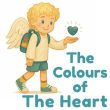How to Read the Invisible Signs of emotional expression in childhood
What’s Behind the Silence, the Tantrum, or the Restlessness?
Things are not always what they seem.
A child who screams, withdraws, or refuses to get dressed may be experiencing an internal conflict they don’t yet have the words to express.
This is a classic example of emotional expression in childhood, where feelings emerge long before words do.
In childhood, emotional language comes before spoken language.
A tantrum might be sadness.
Restlessness might be anxiety.
Silence might be fear.
Defiance might be a cry for connection.
Children don’t cry because they are spoiled.
They don’t scream because they’re being difficult.
They do it because they’re overwhelmed, and they don’t know how to explain it.
This is emotional expression in childhood.
It begins before language. Children feel everything deeply, but can’t yet name it.
Neuroscience explains: your child’s brain is still under construction
According to Dr. Daniel Siegel, author of The Whole-Brain Child, the part of the brain that controls emotions, the prefrontal cortex, is still growing.
This means children react fast, feel big, and struggle to calm themselves down.
Their brain is still learning how to connect thoughts, feelings, and behavior.
That’s why children cry, push, or run away without knowing why.
They are trying to express something they don’t yet understand.
Emotions Without Names Become Behaviors That Ask for Attention
When children don’t yet have the emotional vocabulary to express what they feel, they speak through the body: Crying, clinging, sleep disturbances, loss of appetite or “misbehavior” that may actually be a disguised request for help.
Psychologist and researcher Susan David, known for her work on emotional agility, teaches that naming emotions is the first step in regulating them. When adults don’t help children understand what they feel, those feelings can become confusing, suppressed, or distorted over time.
The Role of Parents as Emotional Translators
Being a good parent doesn’t mean preventing your child from feeling sadness, anger, or fear, it means listening, validating, and helping them translate what’s going on inside.
When an adult says:
— “You got angry because you wanted to keep playing, didn’t you?”
or
— “You felt scared when I left, but I came back. I’m here.”
…they are doing something incredibly powerful: helping the child recognize their own emotions.
This kind of validating presence is both emotionally and neurologically healing.
Studies show that emotionally attuned responses activate the child’s calm and bonding systems, including the orbitofrontal cortex and dopamine reward pathways.
Stories Help Children See Themselves from the Inside Out
One of the most magical ways to teach emotional vocabulary is through storytelling.
When a child sees a character feel what they feel, they relax, identify, and begin to understand they are not alone.
They discover that the feeling has a name.
That it’s normal.
That it passes.
That’s why The Colours of the Heart collection brings emotional expression in childhood to life through symbolic hearts, making invisible feelings visible, meaningful, and filled with light.
Practical Tip: The Invisible Emotion Map
Here’s a gentle activity to do with your child:
Create an “Invisible Emotion Map.”
Draw five hearts on a piece of paper with different faces: fear, anger, sadness, joy, and jealousy.
Talk together about how each emotion feels in the body:
– What does it make us want to do?
– Where do we feel it?
– What does our face look like when we feel it?
This playful exercise helps build emotional awareness while strengthening your bond.
Final Thoughts: Naming Feelings Is an Act of Love
Helping a child name what they feel is like handing them an inner compass.
It teaches them not to get lost in emotional storms, and not to be ashamed of having feelings.
It’s how we raise children who are emotionally resilient, connected, and brave.
And it all begins with a small, sacred act:
Being present.
Listening with the heart.
And offering words when emotions seem too big for their little voices.
🏰 Free resources for your emotional journey as a family:
- Hearts of Courage Memory Game
- Coloring Page of the Courage Heart
- Final Prayer Card from the book
📅 Click here to download
📖 Explore the book “The Fear That Found Courage”
Discover our picture books that help families connect through faith and feelings — see all books here.
For additional guidance on emotional development, the Child Mind Institute offers trusted resources for families.
Through stories, we create a safe space to name what children feel, fear, or need. When we take time to truly see children’s emotions, we build more than calm — we build connection.
📖 References and Further Reading
Gottman, J. & DeClaire, J. Raising an Emotionally Intelligent Child (1997)
Siegel, D. & Bryson, T. The Whole-Brain Child (2012)
David, S. Emotional Agility (2016)
Perry, B. & Szalavitz, M. The Boy Who Was Raised as a Dog (2006)
Denham, S. A. Social-emotional competence and school readiness (2006)
National Scientific Council on the Developing Child, Harvard University (2010)
